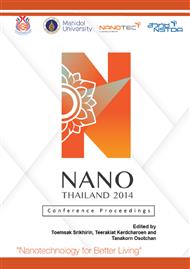[1]
A. Uhlir, Electrolytic Shaping of Germanium and Silicon, Bell System Technology 35 (1956) 333-347.
DOI: 10.1002/j.1538-7305.1956.tb02385.x
Google Scholar
[2]
Z. Mouffak, H. Aourag, J. D. Moreno,J. M. Martinez-Duart, Quantum size effect from n-type porous silicon, Microelectronic Engineering 43–44 (1998) 655-659.
DOI: 10.1016/s0167-9317(98)00240-8
Google Scholar
[3]
H. Diesinger, A. Bsiesy, R. Hérino,B. Gelloz, Effect of the quantum confinement on the optical absorption of porous silicon, investigated by a new in-situ method, Materials Science and Engineering: B 69–70 (2000) 167-170.
DOI: 10.1016/s0921-5107(99)00251-2
Google Scholar
[4]
M. Naddaf,H. Hamadeh, Visible luminescence in photo-electrochemically etched p-type porous silicon: Effect of illumination wavelength, Materials Science and Engineering: C 29 (2009) 2092-(2098).
DOI: 10.1016/j.msec.2009.04.007
Google Scholar
[5]
M. Balarin, O. Gamulin, M. Ivanda, V. Djerek, O. Celan, S. Music, M. Ristic,K. Furic, Structure and optical properties of porous silicon prepared on thin epitaxial silicon layer on silicon substrates, Journal of Molecular Structure 834–836 (2007).
DOI: 10.1016/j.molstruc.2006.12.010
Google Scholar
[6]
S. Zairi, C. Martelet, N. Jaffrezic-Renault, R. M'Gaïeth, H. Maâref,R. Lamartine, Porous silicon a transducer material for a high-sensitive (bio)chemical sensor: effect of a porosity, pores morphologies and a large surface area on a sensitivity, Thin Solid Films 383 (2001).
DOI: 10.1016/s0040-6090(00)01607-2
Google Scholar
[7]
R. S. Dubey,D. K. Gautam, Porous silicon layers prepared by electrochemical etching for application in silicon thin film solar cells, Superlattices and Microstructures 50 (2011) 269-276.
DOI: 10.1016/j.spmi.2011.07.003
Google Scholar
[8]
K. A. Salman, K. Omar,Z. Hassan, The effect of etching time of porous silicon on solar cell performance, Superlattices and Microstructures 50 (2011) 647-658.
DOI: 10.1016/j.spmi.2011.09.006
Google Scholar
[9]
Z. Gaburro, P. Bellutti, R. Chierchia, V. Mulloni,L. Pavesi, Light emitting diodes based on anodically oxidized silicon/porous silicon heterojunction, Materials Science and Engineering: B 69–70 (2000) 109-113.
DOI: 10.1016/s0921-5107(99)00403-1
Google Scholar
[10]
L. N. Acquaroli, R. Urteaga,R. R. Koropecki, Innovative design for optical porous silicon gas sensor, Sensors and Actuators B: Chemical 149 (2010) 189-193.
DOI: 10.1016/j.snb.2010.05.065
Google Scholar
[11]
N. Marrero, R. Guerrero-Lemus, B. González-Díaz,D. Borchert, Effect of porous silicon stain etched on large area alkaline textured crystalline silicon solar cells, Thin Solid Films 517 (2009) 2648-2650.
DOI: 10.1016/j.tsf.2008.09.070
Google Scholar
[12]
A. N. Parbukov, V. I. Beklemyshev, V. M. Gontar, I. I. Makhonin, S. A. Gavrilov,S. C. Bayliss, The production of a novel stain-etched porous silicon, metallization of the porous surface and application in hydrocarbon sensors, Materials Science and Engineering: C 15 (2001).
DOI: 10.1016/s0928-4931(01)00258-2
Google Scholar
[13]
M. Hajji, M. Khalifa, S. B. Slama,H. Ezzaouia, Homogeneous luminescent stain etched porous silicon elaborated by a new multi-step stain etching method, Applied Surface Science 284 (2013) 324-330.
DOI: 10.1016/j.apsusc.2013.07.101
Google Scholar
[14]
M. A. Khan, M. S. Haque, H. A. Naseem, W. D. Brown,A. P. Malshe, Microwave plasma chemical vapor deposition of diamond films with low residual stress on large area porous silicon substrates, Thin Solid Films 332 (1998) 93-97.
DOI: 10.1016/s0040-6090(98)01209-7
Google Scholar
[15]
V. Baranauskas, Laser printing of photoluminescent porous silicon features, Applied Surface Science 154–155 (2000) 605-609.
DOI: 10.1016/s0169-4332(99)00466-3
Google Scholar
[16]
V. Baranauskas, B. B. Li, M. C. Tosin, J. G. Zhao, H. J. Ceragioli, A. C. Peterlevitz,S. F. Durrant, Structural and photoluminescent properties of porous silicon with deep pores obtained by laser-assisted electrochemistry, Surface and Coatings Technology 133–134 (2000).
DOI: 10.1016/s0257-8972(00)00950-6
Google Scholar
[17]
J. Jakubowicz, K. Smardz,L. Smardz, Characterization of porous silicon prepared by powder technology, Physica E: Low-dimensional Systems and Nanostructures 38 (2007) 139-143.
DOI: 10.1016/j.physe.2006.12.017
Google Scholar
[18]
M. J. Sailor, Porous Silicon in Practice: Preparation, Characterization and Applications, Wiley-VCH, Singapore, (2012).
Google Scholar
[19]
V. Lehmann, R. Stengl,A. Luigart, On the morphology and the electrochemical formation mechanism of mesoporous silicon, Materials Science and Engineering: B 69–70 (2000) 11-22.
DOI: 10.1016/s0921-5107(99)00286-x
Google Scholar
[20]
V. Lehmann, Electrochemistry of Silicon: Instrumentation, Science, Materials and Applications, Wiley-VCH, Germany, (2002).
Google Scholar
[21]
W. Lang, P. Steiner,H. Sandmaier, Porous silicon: A novel material for microsystems, Sensors and Actuators A: Physical 51 (1995) 31-36.
DOI: 10.1016/0924-4247(95)01066-1
Google Scholar
[22]
A. Slimani, A. Iratni, J. N. Chazalviel, N. Gabouze,F. Ozanam, Experimental study of macropore formation in p-type silicon in a fluoride solution and the transition between macropore formation and electropolishing, Electrochimica Acta 54 (2009).
DOI: 10.1016/j.electacta.2008.11.052
Google Scholar
[23]
K. Rahmoun, H. I. Faraoun, G. Bassou, C. Mathieu,N. E. C. Sari, Determination of Mechanical Properties of Porous Silicon with Image Analysis and Finite Element, Physics Procedia 55 (2014) 390-395.
DOI: 10.1016/j.phpro.2014.07.056
Google Scholar
[24]
T. Serdiuk, V. Lysenko, S. Alekseev,V. A. Skryshevsky, Size tuning of luminescent silicon nanoparticles with meso-porous silicon membranes, Journal of Colloid and Interface Science 364 (2011) 65-70.
DOI: 10.1016/j.jcis.2011.07.068
Google Scholar
[25]
F. A. Harraz, A. A. Ismail, H. Bouzid, S. A. Al-Sayari, A. Al-Hajry,M. S. Al-Assiri, A capacitive chemical sensor based on porous silicon for detection of polar and non-polar organic solvents, Applied Surface Science 307 (2014) 704-711.
DOI: 10.1016/j.apsusc.2014.04.106
Google Scholar
[26]
M. D. Supardan, Y. Masuda, A. Maezawa,S. Uchida, The investigation of gas holdup distribution in a two-phase bubble column using ultrasonic computed tomography, Chemical Engineering Journal 130 (2007) 125-133.
DOI: 10.1016/j.cej.2006.08.035
Google Scholar
[27]
K. Takamura, H. Fischer,N. R. Morrow, Physical properties of aqueous glycerol solutions, Journal of Petroleum Science and Engineering 98–99 (2012) 50-60.
DOI: 10.1016/j.petrol.2012.09.003
Google Scholar
[28]
A. I. Manilov,V. A. Skryshevsky, Hydrogen in porous silicon — A review, Materials Science and Engineering: B 178 (2013) 942-955.
DOI: 10.1016/j.mseb.2013.05.001
Google Scholar


